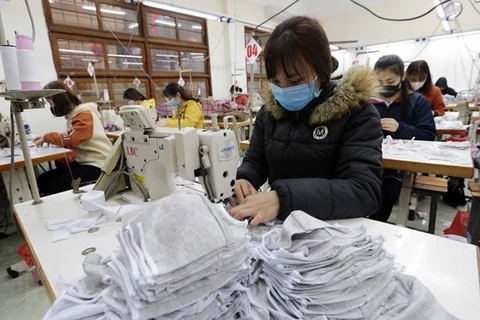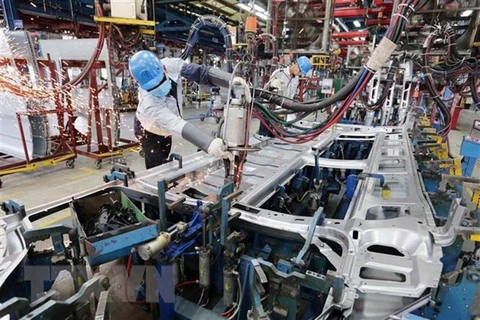 Businesses are stepping up efforts to maintain production and weather difficulties caused by the COVID-19 pandemic (Photo: VietnamPlus)
Businesses are stepping up efforts to maintain production and weather difficulties caused by the COVID-19 pandemic (Photo: VietnamPlus)Hanoi (VNA) – The World Bank (WB) has projected Vietnam’s GDP growth rate this year at 4.8 percent, two percentage points lower than its previous prediction in December 2020.
The prediction was made in the latest edition of Taking Stock – the World Bank’s biannual update on Vietnam’s economic performance, titled “Digital Vietnam - The Path to Tomorrow”. It highlighted the economic pains associated with the most recent COVID-19 outbreak and the mobility measures adopted by the government to contain the pandemic.
The WB noted that the Vietnamese economy expanded by a robust 5.6 percent during the first semester of 2021, but faces serious internal and external risks, including a domestic COVID-19 outbreak, which has spread to most of the provinces since late April. Despite its relative resilience, the Vietnamese economy has been affected by the progressively more restrictive measures to contain the outbreak amid low vaccination rates.
In July, retail sales fell by 19.8 percent year-over-year (y/y), the largest drop since April 2020, while the Purchasing Managers’ Index also declined significantly. It appears that disruptions in industrial zones and supply chains caused by the broad-based COVID-19 resurgence have forced exporters to close factories temporarily or delay production.
On the external front, Vietnam maintained a positive external position, with an increase in international reserves, but both merchandise trade and current account balances deteriorated during the first semester. Growth of imports outpaced that of exports, while the services account continued to be negatively impacted by the closing of the country’s borders to most international visitors. Accumulated foreign direct investment (FDI) inflows were 11 percent lower in the first seven months of 2021 than during the same period in 2020, according to the report.
It added that the State Bank of Vietnam continued its accommodative monetary policies, while the government returned to a more neutral fiscal stance during the first semester. Credit expanded by about 15 percent in recent months, up from 10 to 12 percent in 2020, providing a welcome buffer to affected businesses. However, this policy can also lead to higher risks for the financial sector.
“Whether Vietnam’s economy will rebound in the second half of 2021 will depend on the control of the current COVID-19 outbreak, the effective vaccine rollout, and the efficiency of the fiscal measures to support affected businesses and households, and to stimulate the recovery,” said Rahul Kitchlu, World Bank Acting Country Director for Vietnam.
“While downside risks have heightened, economic fundamentals remain solid in Vietnam, and the economy could converge toward the pre-pandemic GDP growth rate of 6.5 to 7 percent from 2022 onward,” he added.
The report suggests that the authorities should address the social consequences of the COVID-19 crisis by improving the depth and effectiveness of social protection programmes. They should also watch out for rising risks in the financial sector, while greater attention should be given to fiscal policy since policymakers will need to find the right balance between the need to support the recovery of the economy and the necessity to maintain a sustainable level of public debt.
In addition to analysing the recent trends of the economy, this edition focuses on what Vietnam needs to do to realise its ambition of becoming one of the most advanced digital economies in the world. The COVID-19 crisis has accelerated the digital transformation of the local economy as an increasing number of businesses in Vietnam are now offering their services online. The government has also enhanced the digitalisation of its procedures and databases.
The report argues that for most countries in the world, including Vietnam, becoming a digital powerhouse will not be determined by the ability to produce technological breakthroughs, but rather the capacity to make the most of digital technologies developed elsewhere./.























